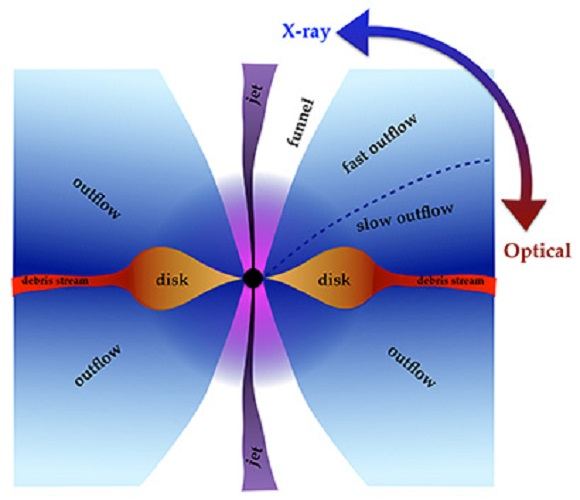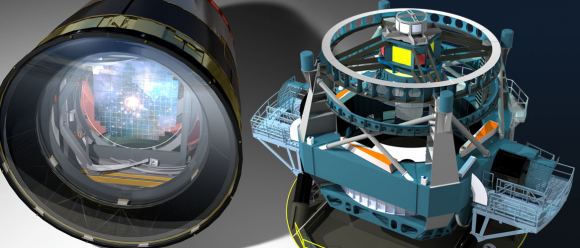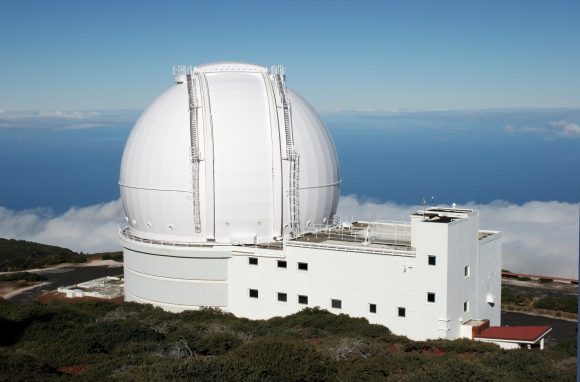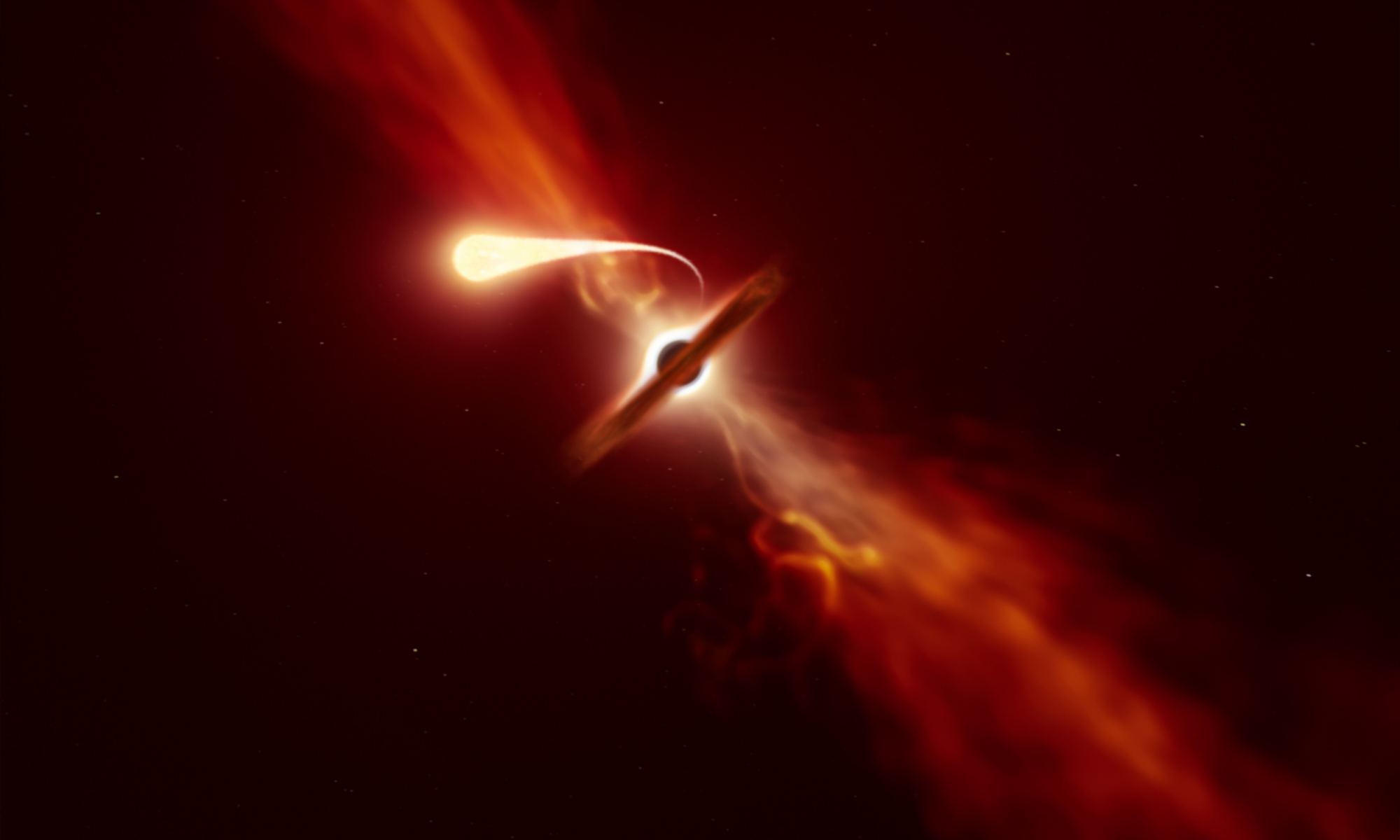Neutrinos are notoriously finicky particles. Hundreds of trillions pass through a person’s body every second, yet they hardly seem to interact with anything (though they actually do a lot). Even more hard to find are the “high energy” neutrinos that are believed to be formed as the outcome of some of the most violent events in the universe. Now, researchers using NASA’s Swift telescope have found a high energy neutrino for the first time from one type of those ultra-violent events – a tidal disruption. But something was a little bit off about it.
Continue reading “Astronomers Track a Neutrino Back to the Source. Where a Black Hole Tore Apart a Star”Astronomers Watch a Star Get Spaghettified by a Black Hole
The gravitational dance between massive bodies, tidal forces occur because the pull of gravity from an object depends upon your distance from it. So, for example, the side of Earth near the Moon is pulled a bit more than the side opposite the Moon. As a result, the Earth stretches and flattens a bit. On Earth, this effect is subtle but strong enough to give the oceans high and low tides. Near a black hole, however, tidal forces can be much stronger, creating an effect known as spaghettification.
Continue reading “Astronomers Watch a Star Get Spaghettified by a Black Hole”Astronomers Watched a Star System Die

About 570 light years from Earth lies WD 1145+017, a white dwarf star. In many respects it’s a typical white dwarf star. Its mass is about 0.6 solar masses, and its temperature is about 15,900 Kelvin. But five years ago, a team of astronomers wrote a paper on the white dwarf, showing that something unusual was going on.
Continue reading “Astronomers Watched a Star System Die”This is What Happens When a Black Hole Gobbles up a Star

At the center of our galaxy resides a Supermassive Black Hole (SMBH) known as Sagittarius A. Based on ongoing observations, astronomers have determined that this SMBH measures 44 million km (27.34 million mi) in diameter and has an estimated mass of 4.31 million Solar Masses. On occasion, a star will wander too close to Sag A and be torn apart in a violent process known as a tidal disruption event (TDE).
These events cause the release of bright flares of radiation, which let astronomers know that a star has been consumed. Unfortunately, for decades, astronomers have been unable to distinguish these events from other galactic phenomena. But thanks to a new study from by an international team of astrophysicists, astronomers now have a unified model that explains recent observations of these extreme events.
The study – which recently appeared in the Astrophysical Journal Letters under the title “A Unified Model for Tidal Disruption Events” – was led by Dr. Jane Lixin Dai, a physicist with the Niels Bohr Institute’s Dark Cosmology Center. She was joined by members from University of Maryland’s Joint Space-Science Institute and the University of California Santa Cruz (UCSC).

As Enrico Ramirez-Ruiz – the professor and chair of astronomy and astrophysics at UC Santa Cruz, the Niels Bohr Professor at the University of Copenhagen, and a co-author on the paper – explained in a UCSC press release:
“Only in the last decade or so have we been able to distinguish TDEs from other galactic phenomena, and the new model will provide us with the basic framework for understanding these rare events.”
In most galaxies, SMBHs do not actively consume any material and therefore do not emit any light, which distinguishes them from galaxies that have Active Galactic Nuclei (AGNs). Tidal disruption events are therefore rare, occurring only once about every 10,000 years in a typical galaxy. However, when a star does get torn apart, it results in the release of an intense amount of radiation. As Dr. Dai explained:
“It is interesting to see how materials get their way into the black hole under such extreme conditions. As the black hole is eating the stellar gas, a vast amount of radiation is emitted. The radiation is what we can observe, and using it we can understand the physics and calculate the black hole properties. This makes it extremely interesting to go hunting for tidal disruption events.”

In the past few years, a few dozen candidates for tidal disruption events (TDEs) have been detected using wide-field optical and UV transient surveys as well as X-ray telescopes. While the physics are expected to be the same for all TDEs, astronomers have noted that a few distinct classes of TDEs appear to exist. While some emit mostly x-rays, others emit mostly visible and ultraviolet light.
As a result, theorists have struggled to understand the diverse properties observed and create a coherent model that can explain them all. For the sake of their model, Dr. Dai and her colleagues combined elements from general relativity, magnetic fields, radiation, and gas hydrodynamics. The team also relied on state-of-the-art computational tools and some recently-acquired large computer clusters funded by the Villum Foundation for Jens Hjorth (head of DARK Cosmology Center), the U.S. National Science Foundation and NASA.
Using the model that resulted, the team concluded that it is the viewing angle of the observer that accounts for the differences in observation. Essentially, different galaxies are oriented randomly with respect to observers on Earth, who see different aspects of TDEs depending on their orientation. As Ramirez-Ruiz explained:
“It is like there is a veil that covers part of a beast. From some angles we see an exposed beast, but from other angles we see a covered beast. The beast is the same, but our perceptions are different.”

In the coming years, a number of planned survey projects are expected to provide much more data on TDEs, which will help expand the field of research into this phenomena. These include the Young Supernova Experiment (YSE) transient survey, which will be led by the DARK Cosmology Center at the Niels Bohr Institute and UC Santa Cruz, and the Large Synoptic Survey Telescopes (LSST) being built in Chile.
According to Dr. Dai, this new model shows what astronomers can expect to see when viewing TDEs from different angles and will allow them to fit different events into a coherent framework. “We will observe hundreds to thousands of tidal disruption events in a few years,” she said. “This will give us a lot of ‘laboratories’ to test our model and use it to understand more about black holes.”
This improved understanding of how black holes occasionally consume stars will also provide additional tests for general relativity, gravitational wave research, and help astronomers to learn more about the evolution of galaxies.
Further Reading: UCSC, Astrophysical Journal Letters
When Galaxies Collide, Stars Suffer the Consequences

When galaxies collide, the result is nothing short of spectacular. While this type of event only takes place once every few billion years (and takes millions of years to complete), it is actually pretty common from a cosmological perspective. And interestingly enough, one of the most impressive consequences – stars being ripped apart by supermassive black holes (SMBHs) – is quite common as well.
This process is known in the scientific community as stellar cannibalism, or Tidal Disruption Events (TDEs). Until recently, astronomers believed that these sorts of events were very rare. But according to a pioneering study conducted by leading scientists from the University of Sheffield, it is actually 100 times more likely than astronomers previously suspected.
TDEs were first proposed in 1975 as an inevitable consequence of black holes being present at the center of galaxies. When a star passes close enough to be subject to the tidal forces of a SMBH it undergoes what is known as “spaghetification”, where material is slowly pulled away and forms string-like shapes around the black hole. The process causes dramatic flare ups that can be billions of times brighter than all the stars in the galaxy combined.
Since the gravitational force of black holes is so strong that even light cannot escape their surfaces (thus making them invisible to conventional instruments), TDEs can be used to locate SMBHs at the center of galaxies and study how they accrete matter. Previously, astronomers have relied on large-area surveys to determine the rate at which TDEs happen, and concluded that they occur at a rate of once every 10,000 to 100,000 years per galaxy.
However, using the William Herschel Telescope at the Roque de los Muchachos Observatory on the island of La Palma, the team of scientists – who hail from Sheffield’s Department of Physics and Astronomy – conducted a survey of 15 ultra-luminous infrared galaxies that were undergoing galactic collisions. When comparing information on one galaxy that had been observed twice over a ten year period, they noticed that a TDE was taking place.
Their findings were detailed in a study titled “A tidal disruption event in the nearby ultra-luminous infrared galaxy F01004-2237“, which appeared recently in the journal Nature: Astronomy. As Dr James Mullaney, a Lecturer in Astronomy at Sheffield and a co-author of the study, said in a University press release:
“Each of these 15 galaxies is undergoing a ‘cosmic collision’ with a neighboring galaxy. Our surprising findings show that the rate of TDEs dramatically increases when galaxies collide. This is likely due to the fact that the collisions lead to large numbers of stars being formed close to the central supermassive black holes in the two galaxies as they merge together.”

The Sheffield team first observed these 15 colliding galaxies in 2005 during a previous survey. However, when they observed them again in 2015, they noticed that one of the galaxies in the sample – F01004-2237 – appeared to have undergone some changes. The team them consulted data from the Hubble Space Telescope and the Catalina Sky Survey – which monitors the brightness of astronomical objects (particularly NEOs) over time.
What they found was that the brightness of F01004-2237 – which is about 1.7 billion light years from Earth – had changed dramatically. Ordinarily, such flare ups would be attributed to a supernova or matter being accreted onto an SMBH at the center (aka. an active galactic nucleus). However, the nature of this flare up (which showed unusually strong and broad helium emission lines in its post-flare spectrum) was more consistent with a TDE.
The appearance of such an event had been detected during a repeat spectroscopic observations of a sample of 15 galaxies over a period of just 10 years suggested that the rate at which TDEs happen was far higher than previously thought – and by a factor of 100 no less. As Clive Tadhunter, a Professor of Astrophysics at the University of Sheffield and lead author of the study, said:
“Based on our results for F01004-2237, we expect that TDE events will become common in our own Milky Way galaxy when it eventually merges with the neighboring Andromeda galaxy in about 5 billion years. Looking towards the center of the Milky Way at the time of the merger we’d see a flare approximately every 10 to 100 years. The flares would be visible to the naked eye and appear much brighter than any other star or planet in the night sky.”

In the meantime, we can expect that TDEs are likely to be noticed in other galaxies within our own lifetimes. The last time such an event was witnessed directly was back in 2015, when the All-Sky Automated Survey for Supernovae (aka. ASAS-SN, or Assassin) detected a superlimunous event four billion light years away – which follow-up investigations revealed was a star being swallowed by a spinning SMBH.
Naturally, news of this was met with a fair degree of excitement from the astronomical community, since it was such a rare event. But if the results of this study are any indication, astronomers should be noticing plenty more stars being slowly ripped apart in the not-too-distant future.
With improvements in instrumentation, and next-generation instruments like the James Webb Telescope being deployed in the coming years, these rare and extremely picturesque events may prove to be a more common experience.
Further Reading: Nature: Astronomy, University of Sheffield


